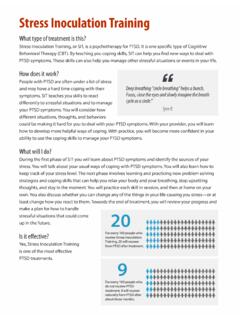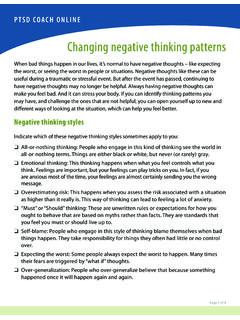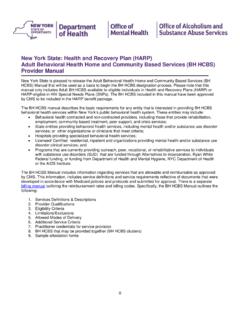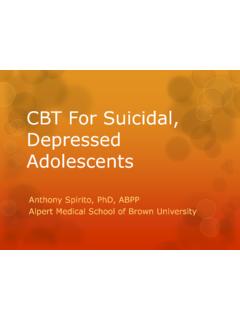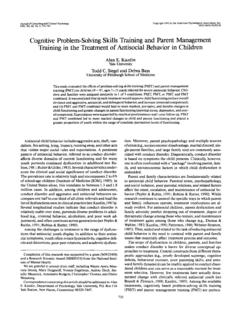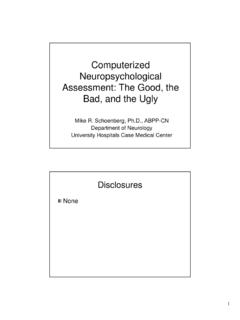Transcription of Meta-Analysis of the Efficacy of Treatments for ...
1 Meta-Analysis . Meta-Analysis of the Efficacy of Treatments for Posttraumatic Stress Disorder Bradley V. Watts, MD, MPH; Paula P. Schnurr, PhD; Lorna Mayo, MD, MPH; Yinong Young-Xu, PhD;. William B. Weeks, MD, MBA; and Matthew J. Friedman, MD, PhD. ABSTRACT. Objective: Posttraumatic stress disorder (PTSD) is Many Treatments for posttraumatic stress disorder (PTSD) have 12. been developed over the past 2 decades. , The Treatments an important mental health issue in terms of the include a variety of psychotherapies, medications, and somatic and number of people affected and the morbidity and complementary therapies. The most commonly studied types of functional impairment associated with the disorder. psychotherapy are cognitive-behavioral therapies (CBTs), such as The purpose of this study was to examine the prolonged exposure, 3, 4 cognitive processing therapy,5, 6 and cognitive Efficacy of all Treatments for PTSD.
2 Therapy,7,8 along with eye movement desensitization and , 10. Data Sources: PubMed, MEDLINE, PILOTS, and Most of the research has focused on individual treatment, although PsycINFO databases were searched for randomized there have been some studies of group-based treatment as well. 11, 12 The controlled clinical trials of any treatment for PTSD most commonly studied medications are antidepressants, particularly in adults published between January 1, 1980, and selective serotonin reuptake inhibitors (SSRIs). Atypical antipsychotic April 1,2012, and written in the English language. medications also have been studied relatively often, although to a far The following search terms were used: post-traumatic 1 3 141 5. lesser extent than antidepressants.
3 , , stress disorders, posttraumatic stress disorder, PTSD, combat disorders, and stress disorders, post-traumatic. The development of practice guidelines has followed the emergence of these Treatments for PTSD. However, despite the existence of practice Study Selection: Articles selected were those in guidelines,16 questions persist regarding how to most effectively treat which all subjects were adults with a diagnosis patients with PTSD. 17 Comprehensive reviews describing the Efficacy of PTSD based on DSM criteria and a valid PTSD. symptom measure was reported. Other study of PTSD Treatments (including both medications and psychotherapy). characteristics were systematically differ in terms of their scope, methods, and conclusions.
4 No single sample consisted of 137 treatment comparisons guideline or review is considered to be definitive. Van Etten and Taylor's drawn from 112 studies. Meta-Analysis 18 is often cited, but it includes no studies published after Results: Effective psychotherapies included cognitive 1997; most studies of PTSD treatment have been published since then. therapy, exposure therapy, and eye movement A report by the Institute of Medicine largely focused on the goal to desensitization and reprocessing (g= , , and "note limitations in the evidence base and make suggestions for further , respectively). Effective pharmacotherapies research."19(p3) This conclusion provides little guidance for clinicians, included paroxetine, sertraline, fluoxetine, who must rely upon current evidence in selecting Treatments for risperidone, topiramate, and venlafaxine (g= , PTSD.)
5 Several reviews 16,20-28 focused only on psychotherapy. Other , , , , and , respectively). For both reviews2, 1 6,29- 31 focused only on the effectiveness of medication. psychotherapy and medication, studies with more We sought to address the gaps in reviews of the PTSD treatment women had larger effects and studies with more literature by conducting a Meta-Analysis of all randomized controlled veterans had smaller effects. Psychotherapy studies clinical trials for PTSD. We used broad inclusion criteria and a treatment with wait-list controls had larger effects than studies with active control comparisons. categorization system designed to allow comparisons across clinically relevant treatment groupings, such as whether a cognitive-behavioral Conclusions:Our findings suggest that patients and treatment was cognitively or behaviorally oriented.
6 Our aim was to providers have a variety of options for choosing an inform clinicians about effective treatment options and thus lead to effective treatment for PTSD. Substantial differences more informed decisions about treatment. in study design and study participant characteristics make identification of a single best treatment DATA SOURCES AND SEARCH STRATEGIES. difficult. Not all medications or psychotherapies are effective. We searched PubMed, MEDLINE, PILOTS, PsycINFO, and the J Clin Psychiatry 2013;74(6):e541-e550 Cochrane databases for articles published between January 1, 1980, and Copyright2013 PhysiciansPostgraduatePress, Inc. April 1, 2012. For PubMed and MEDLINE, we used the search terms post-traumatic stress disorders, posttraumatic stress disorder, PTSD, Submitted: October 11,2012; accepted February 11, 2013.
7 Combat disorders, and stress disorders,post-traumatic. We limited the ( ). results to articles indexed by a thesaurus term as a clinical trial or those Corresponding author: Bradley , MD, MPH, VAMC that included the terms treatment trial, randomized,or controlled trial (11Q), 215 N Main St, White River Junction,VT 05009. in their title or abstract. We searched the entire Cochrane database by hand. For PILOTS, we used the thesaurus terms clinical trial and adults and limited our search to English language publications since J Clin Psychiatry 74:6, June 2013 e541. Watts et al of skills training, cognitive therapy, and exposure were A large number of effective Treatments exist for present in each type of CBT; however, our classification was posttraumatic stress disorder (PTSD), including based on the approach used in most sessions.
8 If a significant psychotherapies and medications. focus was placed on more than 1 of these approaches (cognitive, exposure, or skills), we classified the treatment as mixed. The cognitive, exposure, and mixed categories were No single treatment is most effective or the preferred further divided into clinically meaningful types, eg, primarily treatment for PTSD. exposure was divided into prolonged exposure, simulator exposure (virtual reality), narrative exposure therapy, and other types of exposure. These subgroups included very In addition, we systematically reviewed references similar treatment approaches that typically used the same of all included studies as well as previous review articles and treatment manual. meta-analyses in order to locate additional references.
9 Similarly, we categorized medications by primary classes: antidepressants, atypical antipsychotics, mood stabilizers, STUDY SELECTION a-adrenergic agents, and benzodiazepines. Antidepressants Included studies had to (1) be a clinical trial in which were further classified by mechanism ofaction into venlafaxine participants were randomly assigned to 1 or more active (a serotonin-norepinephrine reuptake inhibitor), SSRIs, Treatments and to a control group; (2) involve only adult tricyclic antidepressants, monoamine oxidase inhibitors, participants (age 18 and older), all of whom met PTSD and other antidepressants (bupropion, mirtazapine, and diagnostic criteria in the Diagnosticand Statistical Manual nefazodone). Types of SSRIs included paroxetine, fluoxetine, of Mental Disorders, Third Edition; Third Edition, Revised; sertraline, and citalopram.
10 Types of atypical antipsychotics or Fourth Edition (DSM-III,DSM-III-R, DSM-IV); and (3) included risperidone and olanzapine. Types of antiadrenergic present pretreatment and posttreatment measures of PTSD agents included the a1 antagonist (prazosin) and a 2 agonist symptoms. (guanfacine) agents. Classification of Treatment Type Classification of Study Characteristics Three authors ( , , and ) developed Two authors ( and ) independently assessed a hierarchy of treatment types to classify studies. After studies for eligibility and rated study characteristics. Initially, reviewing descriptions of the intervention and other details, these authors reviewed 60 studies separately. Because the we classified each study into its smallest group of similar assessments showed excellent interrater reliability (K = ), treatment comparisons.

